
Equidae is the taxonomic family of horses and related animals, including the extant horses, asses, and zebras, and many other species known only from fossils. The family evolved around 50 million years ago from a small, multi-toed ungulate into larger, single-toed animals. All extant species are in the genus Equus, which originated in North America. Equidae belongs to the order Perissodactyla, which includes the extant tapirs and rhinoceros, and several extinct families. It is more specifically grouped within the superfamily Equoidea, the only other family being the extinct Palaeotheriidae.
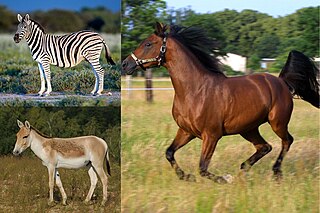
Equus is a genus of mammals in the family Equidae, which includes horses, asses, and zebras. Within the Equidae, Equus is the only recognized extant genus, comprising seven living species. Like Equidae more broadly, Equus has numerous extinct species known only from fossils. The genus originated in North America and dispersed into the Old World and South America during the Early and Middle Pleistocene. Equines are odd-toed ungulates with slender legs, long heads, relatively long necks, manes, and long tails. All species are herbivorous, and mostly grazers, with simpler digestive systems than ruminants but able to subsist on lower-quality vegetation.
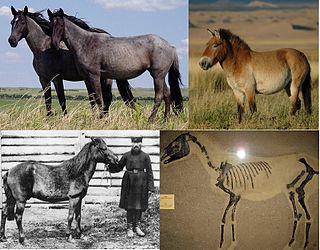
The wild horse is a species of the genus Equus, which includes as subspecies the modern domesticated horse as well as the endangered Przewalski's horse. The European wild horse, also known as the tarpan, that went extinct in the late 19th or early 20th century has previously been treated as the nominate subspecies of wild horse, Equus ferus ferus, but more recent studies have cast doubt on whether tarpans were truly wild or if they actually were feral horses or hybrids.

Equus lambei, commonly known as the Yukon horse or Yukon wild horse, is an extinct species of the genus Equus. Equus lambei ranged across North America until approximately 10,000 years ago. Based on recent examinations of the mtDNA of Equus lambei remains, scientists have concluded that E. lambei was probably much like the extinct tarpan, also known as the Eurasian wild horse, and the living Przewalski's horse. A partial carcass of Equus lambei is on display at the Yukon Beringia Interpretive Centre in Whitehorse, Yukon.

Equus sivalensis is an extinct species of large equid native to the northern Indian subcontinent. Remains date from the beginning of the Pleistocene, c. 2.58 million years ago until around 600,000 years ago, during the Middle Pleistocene. It is considered a "stenonine horse", meaning that it is more closely related to zebras and asses than true horses. Based on isotopes and teeth morphology, it is thought to have been a grazer. The later species Equus namadicus from the same region has sometimes been suggested to be a synonym due to their similar teeth morphology.

Equus namadicus is a prehistoric equid, known from remains dating to the Middle and Late Pleistocene from across the Indian subcontinent, with its last dated records being approximately 29-14,000 years ago. It is considered a "stenonine horse", related to species like the European Equus stenonis, meaning that it is probably more closely related to zebras and asses than true horses. It is relatively large in size. It is very similar to the earlier Equus sivalensis, also from the Indian subcontinent, from which it only differs in size and in subtle aspects of dental anatomy, and it has sometimes been suggested to be a synonym of it.

Hippidion is an extinct genus of equine that lived in South America from the Late Pliocene to the end of the Late Pleistocene (Lujanian), between 2.5 million and 11,000 years ago. They were one of two lineages of equines native to South America during the Pleistocene epoch, alongside Equus (Amerhippus) neogeus.

The evolution of the horse, a mammal of the family Equidae, occurred over a geologic time scale of 50 million years, transforming the small, dog-sized, forest-dwelling Eohippus into the modern horse. Paleozoologists have been able to piece together a more complete outline of the evolutionary lineage of the modern horse than of any other animal. Much of this evolution took place in North America, where horses originated but became extinct about 10,000 years ago, before being reintroduced in the 15th century.
Plesippus is a genus of extinct horse from the Pleistocene of North America. Although commonly seen as a subgenus of Equus recent cladistic analysis considers it a distinct genus.
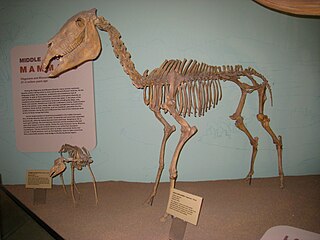
Equus simplicidens, also known as the Hagerman horse is an extinct species of equine native to North America during the Pliocene and Early Pleistocene. It is one of the oldest and most primitive members of the genus Equus. It is the state fossil of Idaho, where abundant remains of the species were discovered near the town of Hagerman in 1928.

The Yunnan horse is an extinct species of equine that was present in East Asia during the Pleistocene very likely as a grazer on open tracts of grassland. It was a small equine comparable in size to the modern Przewalski's horse.

Equus conversidens, or the Mexican horse, was a Pleistocene species of horse, now extinct, that inhabited North America.
Equus alaskae was a Pleistocene species of horse, now extinct, that inhabited North America.
Equus semplicatus was a Pleistocene species of New World stilt-legged horse, and considered the type species for the stilt legged horses, one of three lineages of equids within the Americas, the other two being hippidionid and caballine horses. Now extinct, Equus semiplicatus once inhabited North America.
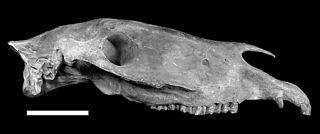
Equus neogeus is an extinct species of equine native to South America during the Pleistocene. It was formerly thought to be several distinct species within the subgenus Amerhippus, but was later shown to be a single morphologically variable species. It is thought to be closely related to true horses.
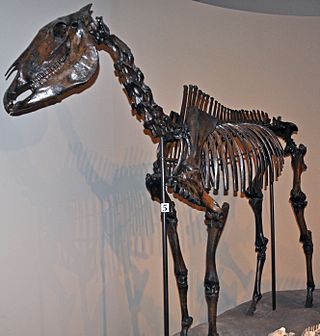
Equus occidentalis is an extinct species of wild horse that once inhabited North America, specifically the Southwestern United States, during the Pleistocene epoch. It was first described from three teeth with insufficient diagnostic characters, one even being suggested to be a separate taxon related to the American Zebra, leading some researchers to consider it a nomen dubium, though this taxonomic debate is yet to be fully resolved.

Horses have been an important component of American life and culture since before the founding of the nation. In 2023, there were an estimated 6.65 million horses in the United States, with 1.5 million horse owners, 25 million citizens that participate in horse related activities, 12 million citizens that spectate at horse events, and 4.6 million citizens involved in businesses related to horses. There are an estimated 82,000 feral horses that roam freely in the wild in certain parts of the country, mostly in the Western United States.

Equus stenonis is an extinct species of equine that lived in Western Eurasia including Europe during the Early Pleistocene.
Equus niobrarensis is an extinct species of Equus, the genus that includes the horse. E. niobrarensis may be synonymous with Equus scotti. It was "stout-legged" and belonged to the "big horses" category as defined by M. C. Winans. The skull of the horse was noted as being broader than Equus caballus.
Equus altidens is an extinct species of equine native to western Eurasia including Europe during the Early Pleistocene to early Middle Pleistocene.
























